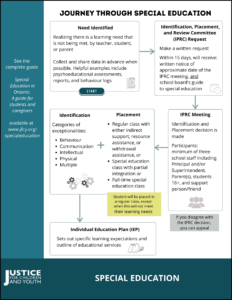- Who’s receiving supports?
- Needs make each of us unique
- How are learning needs identified?
- What is a psychoeducational-assessment?
- Ways to get a psychoeducational assessment
- Exceptionalities
- Placements
- Accommodations, modifications, and alternative programs
- How are students identified as exceptional?
- Journey to Special Education Flowchart
Special Education in Ontario
We all learn differently. Special education helps students who have different learning needs to reach their educational goals in a supportive and inclusive environment.
Every school board in Ontario must provide special education programs and services to students who have special education needs. Students who have these needs have a right to accommodation to enable them to succeed in education. They may also be formally identified with a specific exceptionality, in order to help boards meet these needs.
We sometimes refer to these students who have been identified as “exceptional” students.
If a school board does not have their own special education programs and services, they must arrange for a student to access services and programs at another school board, and to pay for them.
This ensures that all students can succeed and benefit fully from their school experience.
Quick introduction to key special education concepts
- Special Education Programs are set up to support the learning goals of students with unique learning needs. The program is based on ongoing assessment and evaluation, and modified as needed to meet changing needs.
- Special Education Services refer to specific resources, equipment, and specialized support people. They are there to support the overall program and needs of the student.
- The Individual Education Plan (IEP) is the written plan that outlines the special education programs and services being put in place to support the student.
- Some students access special education services after being formally identified as having an exceptionality, through a process called the Identification, Placement, and Review Committee (IPRC). See section on IPRC for further information
- Other students access special education services informally, without going through the IPRC.
- An IEP may be developed without an IPRC process when a teacher has noticed that a student has special learning needs that can be supported, but the learning need has not been formally addressed through the IPRC process, or the need is not so great that the student would be identified as exceptional if an IPRC meeting were held.
Who’s receiving supports?
Of all the students receiving special education supports in Ontario, only 52% have been identified as exceptional through the formal process of an Identification, Placement, and Review Committee (IPRC).
That means that almost half of the students getting special education supports have not gone through a formal process, and may have been introduced to what special education means in ways that may not have answered all of their questions.
This is because going through a formal IPRC process requires schools to provide information on special education in Ontario, however the same requirement is not in place for those that are not formally identified as exceptional.
Needs make each of us unique
We often think of special learning needs, or exceptionalities, as a problem to be managed. Instead, we should think of them as needs that make each of us unique, and an opportunity to provide learning experiences that are different from traditional teaching methods.
We are all different: in our strengths, in our perceptions, and in our upbringings. Education should meet the different human needs of each of us – being different is exactly what makes us human!
How are learning needs identified?
Learning needs can be identified in a variety of ways, such as:
- feedback from the student
- feedback from caregivers
- report cards and teacher observations
- doctor reports
- psychoeducational assessments
School board-funded testing often does not take place until after Grade 3, as students will often have resolved any early learning concerns by that time.
What is a psychoeducational assessment?
These assessments evaluate a student’s cognitive or academic profile, identify abilities, educational achievement levels and underlying causes of any academic difficulty.
The assessment is completed by a psychologist and is a thorough assessment and report on the student’s strengths, needs, academic capacity, and recommendations for teaching and learning strategies.
The report includes six sections:
- Referral and background
- Assessment process or method
- Behavioural observations and impressions
- Test results and interpretations
- Summary and formulation
- Recommendations
Ways to get a psychoeducational assessment?
Psychoeducational assessments are not usually covered by the Ontario Health Insurance Plan (OHIP). If you have group medical insurance through an employer, you can see if the assessment is covered, and to what amount. You will likely need a referral from a medical doctor to get coverage.
Options:
School Board: Talk with your school about seeing a psychologist who works with the school board. This is paid for by the school, if the Principal approves the request. Schools are not obligated to grant psychoeducational assessments. If your school board does provide these services, there may still be wait lists (from a few months to a few years!), and assessments are allocated based on need.
Private Practice: Work with a Psychologist through their private practice. This can be costly, as much as $5000. Some insurance plans may cover some of this cost.
University Psychology Programs: Obtain an assessment through a psychology teaching program at a university. These assessments are done by psychology students who are being supervised by a professor. They may have sliding scale payment options, however there is often an application process and lengthy wait times. Some options:
- Bayridge Counselling Services: for students 6-15 years old, set rate of $2,799
- Ontario Institute for Studies in Education (OISE): $2,300. Accepts applications for fee subsidization based on annual net family income. Rates may go as low as $500
- Queen’s University Regional Assessment and Resource Center: for students who have not had assessments in the prior two years. $2000 with flexible payment plans
- University of Guelph Assessment Services: $2600-$3000
- University of Waterloo Centre for Mental Health Research and Treatment: $500-$2,200, based on annual net family income
The list is not exhaustive and requirements may change. A more regularly updated link is at the ementalhealth.ca website, which includes suggestions on programs and private practice psychologists
Exceptionalities
Exceptionalities are categories of special needs that can affect how a student learns. Students are identified so they can be supported in meeting their full potential. Exceptionalities can include giftedness, disability, and other needs.
Students with exceptionalities have unique learning needs, and school boards are required to support these needs. Support can be provided through accommodations and/or modifications, to support student learning.
There are five different categories of exceptionality in Ontario’s Education Act.
- Behaviour refers to challenges over a period of time, and to such a degree, that it impacts a student’s learning. For example: compulsive reactions, excessive fears, anxiety, difficulties with social interactions.
- Communication refers to challenges that impact a student receiving or relaying information. For example: Autism Spectrum Disorder, Deaf and Hard-of-Hearing, Language or Speech Impairment, Learning Disabilities (such as AD/HD, reading, writing, numbers, processing, fine motor skills).
- Physical refers to a condition that affects the body, where help is needed to support the student’s educational achievement. For example: a physical disability, Blind and Low Vision.
- Intellectual refers to differences in general mental or cognitive abilities – higher or lower – that may affect: intellectual functioning such as learning, problem solving, judgment, or adaptive functioning (activities of daily life), such as communication, or independent living. For example: Giftedness, Mild Intellectual Disability, Developmental Disability.
- Multiple refers to when a student’s needs are in two or more of the above categories of of exceptionality. For example: a student with Autism Spectrum Disorder, who is also gifted would be identified as living with multiple exceptionalities.
Students who do not fit into one of the five categories can still be accommodated. A formal identification as “Exceptional” is not required to access special education services.
Placements
Once identified as having an exceptionality, the IPRC will determine what type of placement is best suited for the student. Placements refer to what type of educational setting would best meet the needs of an exceptional student.
There are five types of special education placements:
- Regular class with indirect support: the student attends a regular classroom for the entire school day; and the teacher receives support from a special education teacher.
- Regular class with resource assistance: the student attends a regular classroom for the entire school day; and will get help from a special education teacher, either individually or in a small group.
- Regular class with withdrawal assistance: the student attends a regular classroom for more than half of the school day; and will will get help from a special education teacher outside of the regular classroom for part of the day.
- Special education class with partial integration: the student will be in a regular classroom less than half of the school day. The remaining part of the school day, the student will receive instruction outside the classroom from a special education teacher.
- Full-time special education class: the student will spend the entire day in a special education class
The student should always be placed in a regular classroom, except when this placement would not be able to meet their needs. Under these circumstances, the IPRC decision must explain the reason for the special education classroom placement.
Maximum class sizes for full-time special education classes differ, based on the level of need. For student with severe learning disabilities, the maximum is eight students in one class, with a qualified special education teacher. Mixed exceptionality classes may have up to 16 students with one teacher. For more information on special education classroom placements, see Regulation 298 of the Education Act, section 31.
In addition to the five placement options, the IPRC can also refer the student to one of the Provincial and Demonstration Schools. Students must meet eligibility requirements for admission to enter:
- into a provincial school for the blind, deaf, or deaf-blind, or
- a provincial demonstration school for students with severe learning disabilities.
- Learn more at www.pdsbnet.ca
Accommodations, modifications, and alternative programs
The Individual Education Plan (IEP) will include information about any accommodations, modifications or alternative programs that are put in place to support student success and achievement. This includes graduation and post-secondary readiness.
Accommodations are the teaching and assessment strategies, supports, or equipment used to meet a student’s learning need. They change how the curriculum is delivered.
Modifications are the changes made to the grade level learning expectations for a subject or course. They change what the student will be learning.
Alternative programs, or alternative skill areas, are developed to support students in acquiring knowledge and skills outside of the Ontario school curriculum.
How are students identified as exceptional?
Students with exceptionalities require special education programs or services to meet their learning needs.
They are identified as exceptional through the Identification, Placement, and Review Committee (IPRC). The purpose of the IPRC is to document the student’s strengths and needs; and to make decisions about identification and placement.
I = Identification: deciding if the student is “exceptional”
P = Placement: deciding the best placement for the student
R = Review: deciding whether the Identification & Placement are still appropriate
C = Committee: the Principal (or Superintendent) & two other school staff
The IPRC identifies any of the exceptionalities a student has, and places them in the appropriate special education program or with the appropriate special education service, if needed. Placements are meant to be the least intrusive option available while still meeting the unique learning needs of the student.




